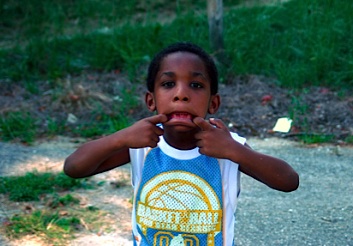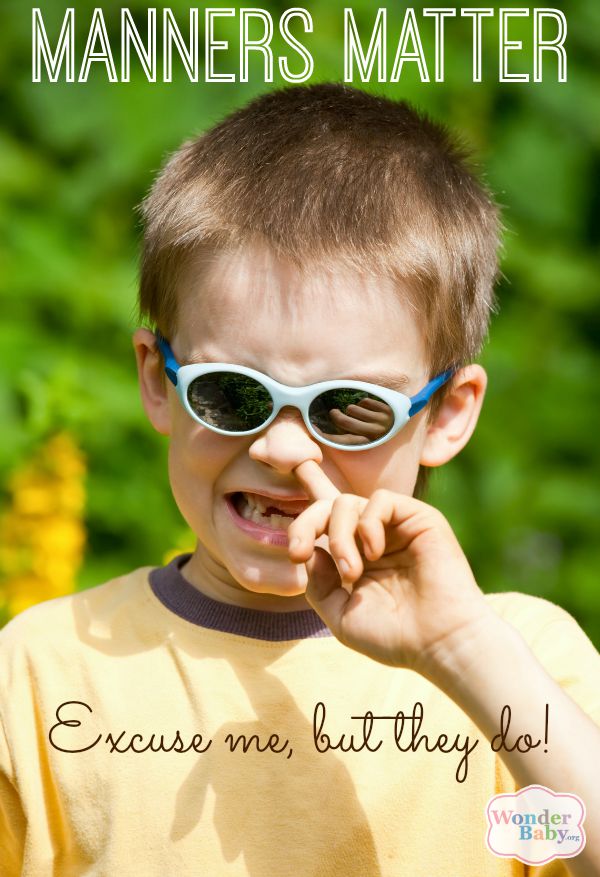Manners Matter (excuse me, but they do!)

Behaving properly is like playing a game: You need to learn the rules in order to fit in to society.
And there are so many rules!
As the parent of a visually impaired child, you could argue that other people should simply recognize your child’s limitations and make exceptions for him. However convenient this may be, though, you would be forgetting the massive benefits he could accrue simply by knowing the rules and playing the game properly.
Do your child a favor: Don’t excuse her behavior; correct it!
We are all impressed when we meet children who are well-behaved and well-mannered. It’s easier to like a child who conforms to what our social expectations are—they seem less strange to us.
This is a good thing. Children are vulnerable on any number of fronts and if, by social shorthand, they can make adults (or other children) feel comfortable quickly, if their behavior and mannerisms are easily understood, this leads to quick acceptance which allows them to form strong, positive relationships in new groups. This builds to a transferable skill which will serve them well throughout their life and lead to more confident personalities and happier lives.
Of course, like most things in life, our blind and visually impaired children need the benefits that this behavior brings but are significantly disadvantaged (compared to most sighted children) in their ability to easily learn and effectively use good manners. They do not see the myriad of visual gestures and expressions which teach sighted kids about social competence, but blind and visually impaired children have at least as much need to understand and utilise this behavior as other children (if not more).
Like all taught behaviors, good manners are first learned and practiced within the family where mistakes can be easily corrected. Here are a few tips to help you teach your child the fundamentals of good manners:
-
- Children learn most directly from our behavior:
If you never thank your child then, seriously, what are the chances that your child will learn speech patterns which naturally incorporate this small, but significant, pleasantry?
- Children learn most directly from our behavior:
-
 Teach your child about the importance of facial expressions:
Teach your child about the importance of facial expressions:
It can be much more difficult for a blind or visually impaired child to stop feelings of distaste, dislike, disbelief, or boredom from showing plainly on his face, but as parents we are in a great position to help our kids to develop the “social façade” which sighted kids readily adopt.
-
- Almost all examples of good manners have a logical, functional root:
For blind and visually impaired children, polite phrases, and of course a host of other parts of speech we perceive as being good manners, can offer a short-cut to meanings and book-mark conversations.When you are at a door with someone else and you wave them ahead of you saying, “After you,” you are saving yourself the confusion and banged head you both get trying to get through the same door at the same time. When you address someone by their name, “How are you, John,” you get a much quicker response than when you call, “Hey, you,” and when you don’t know the name, even, “Excuse me,” works faster. It can be really useful to explain the functions of polite behaviors to your child, because if it makes sense to do a particular thing, they are more likely to do it.
- Almost all examples of good manners have a logical, functional root:
-
- Children love rules:
A guideline is not a guideline in the hands of an enthusiastic child; it’s an incontrovertible law, and they love pointing out when others break that law (a friend’s kid brother even going to the trouble of pointing out the dogs bad manners by telling her “Be ashamed of yourself!”) You should be aware that, once the pattern is set, it may take an act of God to stop your child from correcting the manners of your friends and neighbors! (Until, of course, he understands that “good manners” prohibit him correcting someone else’s manners!!)
- Children love rules:
-
- Fill in the visual clues and cues your child is missing:
Imagine this scenario: In a restaurant, your spouse holds his fork, and in a beseeching manner indicates with a look that he’d like to taste the appetizing meal on your plate. You nod your acquiescence, and he eats. That’s common behavior. Your child mimicking the same move however, will have missed the non-verbal part and gone straight for your plate; which seems rude and ill-mannered to everyone but you.It may initially appear like a good idea to lose the non-verbal communications, but your child will live in a sighted world: better to explain all that is happening so that he develops an understanding of all the social niceties than you change your behavior to accommodate his visual acuity: no-one else will.
- Fill in the visual clues and cues your child is missing:
-
 Good manners at mealtimes are essential and are most easily learned in childhood:
Good manners at mealtimes are essential and are most easily learned in childhood:
Undoubtedly, being blind or visually impaired will not hamper our children from growing into great adults, but who wants to share mealtimes with a great adult who always finishes a meal wearing the food?Sighted children do not “magically” learn how to behave at mealtimes; they gradually learn which behaviors are acceptable by watching what is going on around them. When a parent tells them not to chew with an open mouth, they can immediately see that everyone else closes their mouth to eat.Blind or visually impaired children, on the other hand, need more verbal prompting and reminders because they cannot see the behavior to model. It is essential to remember however, that the main purpose of having a family meal is to enjoy the company of each other whilst you eat. Suggestions and observations, encouragement and cajoling, all have their place here: Criticism and anger do not!
-
- Some situations have developed very structured rules and conditions which have, over time, become social imperatives:
The good thing for children learning about the rules in these situations is precisely that they are so rigid; it can be like learning a dance. A great example of this, for me, is the Catholic Mass: There is an emphasis on procedure and order which, once learned, has a rhythm and discipline never forgotten.Often, Churches and Chapels have an area designated for children, the elderly, and other people who may need assistance and this is an ideal place for a blind or visually impaired child to learn the rudiments of the behavior expected of him whilst receiving the verbal prompts he needs without disruption to the main congregation.
- Some situations have developed very structured rules and conditions which have, over time, become social imperatives:

-
- Help your child understand that appropriate behavior is often situation dependant:
Your 8 year old boy may be able to entertain his brothers (and probably every other male within earshot) by passing wind to the tune of “Mission Impossible,” but how impressed will other passengers be when he does it on the bus—or (horror!) at church? You don’t want the entire congregation thinking your child is a wild animal! Contrary to popular belief, the secret of humour is often not in timing but in knowing your audience!
- Help your child understand that appropriate behavior is often situation dependant:
-
- Teach your child that some places have very strict social rules:
A good example of this is almost any situation involving a toilet. Public toilets in particular, have rigid rules governing behavior and manners which we, as sighted adults, rarely have cause to consider. Voices are kept muted, the queue order is rarely decided on need, all undressing and subsequent redressing is completed within the toilet cubical—none of these common ways of behaving within a public toilet are self-explanatory and your child will need time, practice, and good reason to become adept at this.In this type of situation, it is very important that your child is able to follow the rules because people become very uncomfortable precisely because some behaviors are so heavily proscribed.
- Teach your child that some places have very strict social rules:
- Don’t excuse poor manners—fix them!
No matter how embarrassing or distressing you find it to broach a subject—who else will? You are the best teacher and ally your child will ever have so don’t ignore inappropriate behavior now in the hope that it will rectify itself; realistically, you know it won’t.
So much is so often supposed or presumed on the basis of a person being well-spoken, polite, or simply at ease that it would be silly not to help our children use this as a natural advantage. Blind and visually impaired kids have more reason than most to understand and benefit from the display of easy-going, accepting, and inclusive behavior. Their disability will ensure that they will make more mistakes like tripping, falling, or bumping into others and where others can make immediate sense of environments and situations by virtue of their eyesight, our children will always need a little longer or a little more explanation.
As Oscar Wilde said:
It is absurd to divide people into good and bad. People are either charming or tedious.
This is a credible observation about how even outright flaws can be overlooked if your behavior is acceptable! Do your child a favor—don’t excuse their behavior; correct it!
Giving blind or visually impaired children a strong foundation of good manners will also give them the ability to deal with almost any situation with grace and good humour. Currently, my 4 year old daughter waits briefly after saying thank you and, if the desired response is not quickly forthcoming she will fill it in, saying “It was your pleasure.”
It’s a delightful and endearing faux pas.
And (almost always) she is right!

Related Posts

Behavior
Understanding Intermittent Explosive Disorder in Children
Are you worried about your child’s unexpected aggression and explosive behaviors? Learn how to support a child with intermittent explosive disorder.

Behavior
5 Emotional Regulation Activities for Kids
Want to teach your child how to regulate emotions? Here are emotional regulation activities for kids that can help!

Behavior, Special Needs
5 Tips for Dining Out with Children Who Have Sensory Sensitivities
Worried about dining out with sensory sensitivities? Try these tips for less stress and more fun the next time you take your family out to eat.